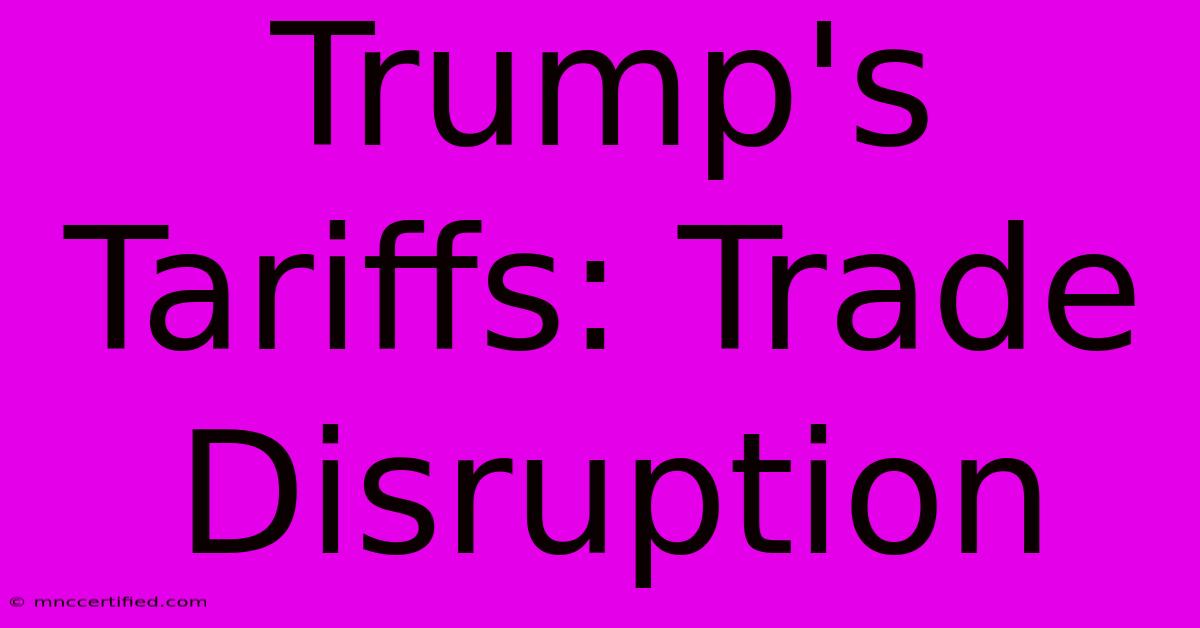Trump's Tariffs: Trade Disruption

Table of Contents
Trump's Tariffs: Trade Disruption and Global Economic Fallout
Donald Trump's presidency was marked by a significant shift in US trade policy, characterized by the imposition of tariffs on various imported goods. This aggressive approach, while aimed at protecting American industries and jobs, triggered widespread disruption in global trade and sparked considerable debate about its economic consequences. This article delves into the impact of Trump's tariffs, exploring their rationale, effects on different sectors, and lasting implications for the global economy.
The Rationale Behind the Tariffs
Trump's tariff strategy stemmed from a belief in protectionism, arguing that unfair trade practices by other countries, particularly China, had harmed American businesses and workers. He aimed to level the playing field through retaliatory tariffs, aiming to:
- Reduce the trade deficit: The US trade deficit, the difference between imports and exports, was a major concern for the Trump administration. Tariffs were seen as a tool to decrease imports and boost domestic production.
- Protect American industries: Specific sectors, such as steel and aluminum, were targeted to shield them from foreign competition, perceived as unfairly subsidized or dumped (sold below market value).
- Negotiate better trade deals: Tariffs were often used as leverage in negotiations with trading partners, aiming to secure more favorable terms for the US.
However, the effectiveness of these goals is hotly debated among economists.
Impact on Different Sectors
The consequences of Trump's tariffs were far-reaching and varied across different sectors.
Winners and Losers
-
Winners: Some domestic industries, particularly those directly protected by tariffs, experienced short-term benefits. This included certain segments of the steel and aluminum industries. However, the long-term benefits are questionable, as higher input costs for other industries offset any gains.
-
Losers: Many industries reliant on imported goods faced significant challenges. Higher input costs led to increased prices for consumers, reduced competitiveness for American exporters who relied on cheaper imported components, and job losses in industries reliant on global supply chains. The agricultural sector, a key export industry, was particularly hard hit by retaliatory tariffs imposed by other countries.
The Consumer Burden
Consumers ultimately bore a significant portion of the cost of Trump's tariffs. Higher prices on imported goods led to decreased purchasing power and a reduction in overall consumer spending. Studies suggest that the tariffs resulted in a significant net loss for American consumers.
Global Economic Fallout
Trump's tariffs were not isolated events; they triggered a global trade war, with countries retaliating with their own tariffs. This led to:
- Reduced global trade: Uncertainty and higher trade costs hampered international commerce, slowing down global economic growth.
- Supply chain disruptions: Businesses faced challenges in sourcing inputs and distributing goods across borders, increasing costs and leading to production delays.
- Increased inflation: Higher prices on imported goods contributed to inflationary pressures globally.
Lasting Implications
The lasting impact of Trump's tariffs remains a subject of ongoing analysis. While some argue that they served to renegotiate certain trade deals, critics point to the significant economic costs and the damage inflicted on the global trading system. The long-term effects on global trade relationships and the stability of the international economic order are still unfolding.
SEO Keywords Used:
- Trump's tariffs
- Trade disruption
- Global economic fallout
- Protectionism
- Trade deficit
- American industries
- Retaliatory tariffs
- Agricultural sector
- Supply chain disruptions
- Global trade war
- Inflation
This article incorporates various SEO techniques, including keyword optimization, header structuring, bold text for emphasis, and a logical flow to enhance readability and search engine ranking. Remember to further optimize this article through off-page SEO strategies such as link building from reputable sources.

Thank you for visiting our website wich cover about Trump's Tariffs: Trade Disruption. We hope the information provided has been useful to you. Feel free to contact us if you have any questions or need further assistance. See you next time and dont miss to bookmark.
Featured Posts
-
Insurance Back Office Services
Nov 27, 2024
-
2nd Odi Zimbabwe Pakistan Highlights
Nov 27, 2024
-
Feyenoord Comeback Man Citys 3 Goal Lead Gone
Nov 27, 2024
-
Incapacitated Wendy Williams Tmz News
Nov 27, 2024
-
Long Insurance Group Tucson Az
Nov 27, 2024